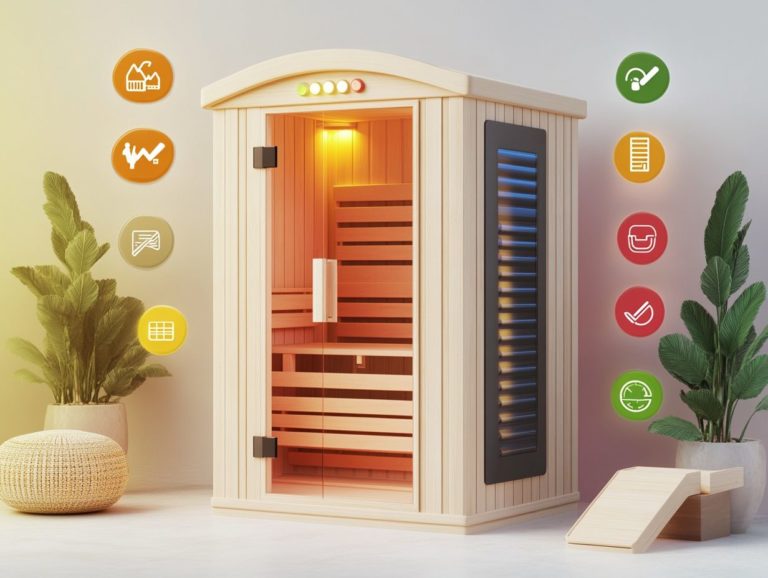Sauna Safety: The Impact of Leadership
Saunas provide a serene retreat, but safety should always come first.
Recognizing the associated risks and building a safe environment is essential for individuals and organizations alike.
This article explores the pivotal role of leadership in promoting sauna safety, highlights common issues, and offers best practices for safe usage.
Whether you re an avid sauna user or managing public facilities, you ll gain valuable insights to ensure a safe and enjoyable experience for everyone.
Contents
- Key Takeaways:
- The Importance of Sauna Safety
- Leadership’s Role in Sauna Safety
- Common Sauna Safety Issues
- Best Practices for Sauna Safety
- Ensuring Sauna Safety in Public Facilities
- Frequently Asked Questions
- 1. What is the role of leadership in ensuring sauna safety?
- 2. How can leaders promote a culture of safety in the sauna?
- 3. Are there any specific safety regulations for saunas?
- 4. What should a leader do in case of an emergency in the sauna?
- 5. How can sauna leaders ensure the safety of their patrons?
- 6. Why is it important for leaders to prioritize sauna safety?
Key Takeaways:

- Effective leadership is crucial for sauna safety.
- Training and protocols can reduce sauna-related incidents.
- Regular inspections are essential for safety.
The Importance of Sauna Safety
Sauna safety is an essential consideration you shouldn’t overlook, especially in public facilities like XSport Fitness, which attract many members, including elderly individuals eager to enjoy the many health benefits of sauna use.
Proper management of sauna environments is vital for maximizing cardiovascular health while ensuring every member enjoys their experience and minimizing risks like dehydration risks and sauna fires.
By understanding the importance of safety protocols and fostering effective leadership within teams overseeing sauna operations, you can create a healthier and more enjoyable environment for all users.
Understanding the Risks
Understanding the risks associated with sauna use is vital for ensuring your experience is both enjoyable and safe, especially if you have existing health problems like cardiovascular or kidney disease.
For individuals in this category, the dangers of dehydration can be heightened, potentially worsening any existing conditions. Prolonged exposure to heat can significantly raise skin temperature, leading to serious issues like heat exhaustion or heat stroke if not properly monitored.
It s important to prioritize hydration by drinking water before and after your sauna session. It s also important to seek medical advice; professionals can provide tailored recommendations, especially if you have any underlying health concerns.
By listening to expert opinions and following safe practices, you can fully enjoy your sauna sessions while minimizing any associated risks.
Leadership’s Role in Sauna Safety
Effective leadership is essential in fostering a culture of safety within sauna operations. As a leader, you must prioritize member safety while also promoting team collaboration.
It’s important to ensure adherence to maintenance guidelines for various sauna types, including Finnish saunas, traditional saunas, and infrared saunas. Your commitment to these aspects enhances the experience for members and sets a standard for operational excellence. Additionally, understanding sauna safety and the value of gratitude can further enrich the benefits of sauna use.
Creating a Culture of Safety

Creating a culture of safety within sauna environments requires establishing clear protocols and guidelines that focus on member satisfaction while effectively managing risks.
By incorporating regular inspections and deep cleaning into your routine, you can ensure that all equipment is functioning correctly and that any potential hazards are swiftly addressed. Combined with well-placed signage that clearly communicates safety measures and guidelines, these strategies not only educate members but also foster a sense of security.
As patrons become more informed and feel protected, the likelihood of accidents decreases, leading to better health outcomes. Ultimately, this allows members to fully enjoy their sauna experience, knowing that their well-being is prioritized, which enhances their overall satisfaction and loyalty to the facility. For more insights, check out sauna safety: the impact of encouragement.
Effective Training and Protocols
Implementing effective training and protocols is essential for ensuring that you and your team fully grasp the significance of sauna interventions and member safety.
Understanding the importance of sauna interventions nurtures a culture of accountability among team members and empowers everyone to act decisively in upholding safety standards. This enhances member safety. Teamwork is key in fostering this culture; collaboration allows staff to exchange insights and experiences that enrich their collective knowledge, including sauna safety practices.
Health studies underscore that structured training interventions can significantly reduce the risks associated with sauna use. Well-trained staff are far better equipped to identify potential hazards and react appropriately, especially regarding humidity levels and temperature controls. For more information on sauna safety and accountability, consider reviewing best practices.
By prioritizing comprehensive training programs, you can effectively minimize sauna-related incidents, creating a safer environment that benefits both employees and patrons alike, especially by understanding the impact of environment on sauna safety.
Common Sauna Safety Issues
Be aware of common sauna safety concerns that can impact your experience, from the risk of causing sauna fires and incorrect humidity levels to widespread harmful myths that could prevent you from fully reaping the health benefits of your sauna sessions, including sweating therapy.
Identifying and Addressing Common Problems
Identifying and addressing common issues in sauna environments is essential for maintaining high safety standards and enhancing health outcomes.
This requires a comprehensive understanding of the unique challenges posed by different sauna types, be it traditional saunas, infrared saunas, or steam rooms. You should be mindful of potential problems such as inadequate temperature control, humidity levels, or the growth of mold and bacteria that can arise if cleaning practices are overlooked. For more insights on how to ensure safety in these environments, check out sauna safety tips for local establishments.
To tackle these concerns, it s vital to establish a regular cleaning schedule using appropriate disinfectants and ensure proper ventilation to minimize moisture buildup, preventing mold and bacteria. Conducting regular inspections can significantly extend the lifespan of your sauna equipment and provide insight into maintenance needs, ultimately creating a more enjoyable and healthier experience for all users.
Best Practices for Sauna Safety

By implementing best practices for sauna safety, you not only elevate the user experience but also significantly reduce the risks associated with sauna use, such as dehydration and overheating. This ensures that you and your fellow members can fully enjoy the myriad benefits of sweat therapy in a secure and inviting environment.
Tips for Safe Sauna Use
To truly harness the health benefits of sauna use while prioritizing your safety, it’s vital to adhere to specific guidelines during your sessions.
These guidelines elevate your experience and help mitigate potential risks associated with prolonged heat exposure, ensuring maintaining a safe temperature during your sessions. Ideally, you should limit your sauna sessions to about 15-20 minutes, particularly if you’re new to this or sensitive to heat. Staying hydrated is essential; drinking water before and after your sauna time will replenish lost fluids and support optimal body function.
It s also wise to ensure that clear signage is prominently displayed, informing you about recommended durations, hydration tips, and any health risks involved. This fosters a safe and enjoyable environment for all.
Regular sauna use has been associated with a variety of benefits, including improved circulation, reduced stress levels, and enhanced skin health, making it an invaluable addition to your wellness routine.
Ensuring Sauna Safety in Public Facilities
Ensuring sauna safety in public facilities is crucial for maintaining member satisfaction and complying with the regulations that govern sauna operations, including proper maintenance tips and service outsourcing. By prioritizing these safety measures now, you enhance the experience for your patrons and uphold the integrity of your establishment.
Regulations and Inspections
Regulations and inspections are pivotal for sauna safety in public facilities. They ensure that every necessary safety measure is in place to protect you and other members.
These guidelines cover everything from temperature controls and ventilation to materials used in construction, all working together to minimize potential hazards. Regular inspections are vital! They help quickly spot wear and tear, enabling facility managers to address maintenance needs swiftly, which is essential for managing risks effectively.
By following these established standards, operators not only protect your well-being while you enjoy the sauna experience but also cultivate a culture of accountability. This proactive approach is essential in reducing risks like overheating or inadequate sanitation, ultimately creating an environment that prioritizes your health, tranquility, and overall safety. For more information on this, check out sauna safety and the role of advocacy.
Frequently Asked Questions

1. What is the role of leadership in ensuring sauna safety?
Leadership plays a crucial role in establishing and promoting a safe sauna environment. Leaders set an example by following safety protocols and ensuring they are properly trained to handle emergencies.
2. How can leaders promote a culture of safety in the sauna?
Leaders can promote safety by regularly communicating and reinforcing safety procedures, conducting safety training for staff and patrons, and taking proactive measures to prevent accidents.
3. Are there any specific safety regulations for saunas?
Yes, there are specific regulations set by organizations such as the International Sauna Association that address safety measures for saunas. These include proper ventilation, temperature control, and guidelines for sauna equipment and materials.
4. What should a leader do in case of an emergency in the sauna?
In an emergency, the leader should remain calm and follow established emergency protocols. They should be trained in basic first aid and know how to handle situations like burns or fainting.
5. How can sauna leaders ensure the safety of their patrons?
Leaders can ensure the safety of patrons by regularly inspecting sauna facilities for hazards, providing clear safety instructions and warning signs, and having well-trained staff to assist and monitor patrons during sessions.
6. Why is it important for leaders to prioritize sauna safety?
Prioritizing sauna safety ensures the well-being of patrons and helps maintain a positive reputation for the facility. By showing a commitment to safety, leaders can attract and retain more customers, creating a safer and more enjoyable experience for all.
Stay safe while enjoying your sauna experience! Always keep these safety tips in mind.






